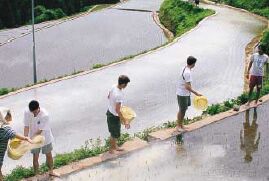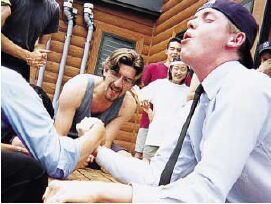JTW 2001-2002
from Princeton University, USA

| 国際交流 3 |
九州大学が他大学に先駆けて始めた、学部学生対象の短期留学プログラム"Japan in Today'sWorld"(JTW)。この夏に修了した第8期に参加したMatthew Angel君(米国プリンストン大学)が、Field Studyとして行われた佐賀県西有田町の棚田での田植え体験について書いてくれました。
|
Matthew Angel JTW 2001-2002 from Princeton University, USA |
 |
In the summer of 2002, we, the students of Kyushu University's Japan in Today's World (JTW) foreign exchange program, in an effort to get a feeling for what Japanese rice farmers must undergo every year at planting time, removed our shoes and socks and ventured out into the rice paddies of the town of Nishi Arita. After a relaxing night in a local inn, which included a traditional Japanese dinner and bath, we were bussed to the fields and instructed by several local farmers in the correct method of planting rice seedlings in the ten-inch deep mud. As I was standing, more than ankle deep in the cool, dark mud, swatting mosquitoes, I was reminded of the words of my physician, whom I consulted regarding vaccinations prior to coming to Japan. "You don't need that one unless you're going to be wading around in rice paddies," she said.

One of the unique aspects of the JTW Program is that it introduces foreign students to a variety of rich cultural activities such as participating in a traditional tea ceremony and visiting a Sumo stable. The trip to Nishi Arita, however, stood out from the other field-study trips as it gave us a chance to interact with the people of Nishi Arita on a personal level, as we worked together in the fields, and then again as we enjoyed a barbeque lunch together. Although we were only in the fields for about twenty minutes, having to constantly bend at the waist to plant the seedlings for even that short of a time gave us sore backs, and taught us what it must be like for the local farmers who work full-time in the fields.
After we filled two small terraces with neat rows of rice seedlings, a local farmer told us that to inhibit weed growth, we must cover the fields with the husks of the previous season's crop that had been ground into a fine powder. The layer of powdered rice husks prevented light from penetrating the surface of the approximately two-inch thick layer of water covering the ten-inch deep mud. He then told us that this was the traditional method of preventing weeds in rice fields that is now used in place of chemicals by farmers who want to grow rice without using potentially dangerous artificial weedkillers.Once we had finished toiling in the fields, we all climbed down into a nearby creek and washed the mud from our feet. Having experienced a Japanese mud skin treatment the likes of which is available at only the most sheik health spas, we were ready for lunch.

As we and the farmers sat down and prepared the barbecued meat and vegetables, we couldn't help but feel that we now had something in common. We had shared an experience with the people of Nishi Arita that most Japanese people had never experienced themselves. Even the JTW tutors (Japanese students at Kyushu University) who came with us to Nishi Arita commented that they had never before planted rice, and now had a new appreciation for the farmers who provide the people of Japan with their staple food.
After everyone had had their fill and had enjoyed one or two cans of beer, some of the students began arm wrestling at one of the picnic tables nearby. Soon, everyone was gathering around the table, waiting for their turn to test their strength. After a couple of bouts, one of the local farmers, an elderly, energetic man, began refereeing the contest. Soon, everyone was arm wrestling, the students, staff, farmers, and even the bus driver. Those who weren't wrestling were cheering or taking pictures on the sidelines. This was the sort of impromptu bonding between the students and the farmers that could not have been planned, and will stay with us in our memories forever.
After we had all finished eating, relaxing, and bonding, we climbed back on the bus and bid farewell to our hosts. I think that many of us were surprised at how much we had become attached and how difficult it was to say goodbye to the friends that we had made in such a short time. Indeed, the field study trip to Nishi Arita was one of the highlights of my year in Japan, and I would strongly recommend that anyone thinking of studying abroad in Japan spend some time in the countryside, for it will surely give someone interested in Japanese culture and the Japanese way of life memories that they will not soon forget, as it has given to all of us in the JTW Program.